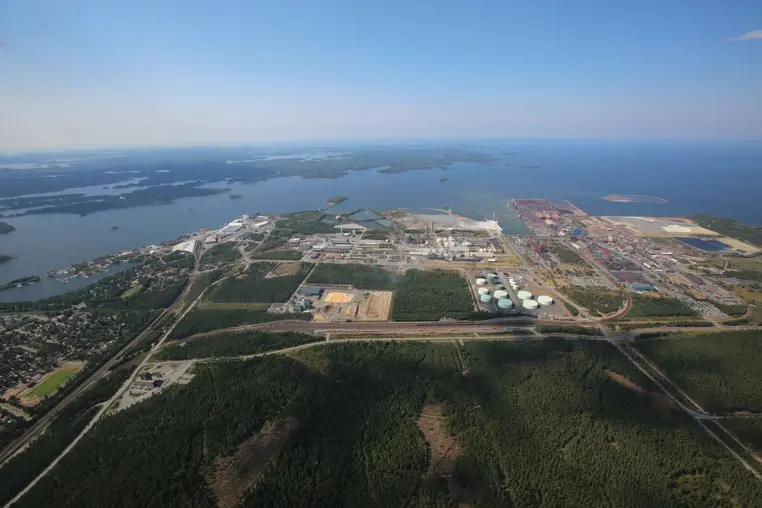Clean energy & grid excellence: Finland’s industrial parks
Is your company looking to set up an industrial operation in Europe? With its abundant supply of clean and affordable energy, Finland is preparing plug-and-play super sites to power your business.
News 10.1.2025

The benefits of industrial parks are widely recognized: ready infrastructure, power connections, access to support services and established lines of transport. It’s quicker for a company to establish a new facility in these parks, while ongoing operations are more efficient too.
But companies now need even more. Under pressure to meet CO2 targets while keeping costs down, industrial operators must also consider the grid’s energy mix and electricity prices. Grid reliability is another factor – businesses need a guaranteed source of power.
Finland’s national grid operator Fingrid said that the country’s transmission reliability rate in 2023 was "99.99995% – the best on record". The Finnish grid is also among the cleanest in Europe. Windpower accounts for more than 40% of capacity and hydropower is at almost 20%. Finland’s energy is extremely cost competitive too. In the first half of 2024, non-household electricity prices were the lowest of any country in the European Union.
"Many of our industrial parks are tailored to meet the specific needs of different sectors."
Recognizing the opportunity presented by this abundance of reliable, clean and affordable energy, Finland’s is driving national investment and growth through industrial parks.
"We work with international investors to select appropriate sites. Many of our industrial parks are tailored to meet the specific needs of different sectors. We have done a lot of the groundwork for companies looking to set up here," explains Markku Kivistö, Head of Industry, Cleantech at Invest in Finland, part of Business Finland.
"We have a clear picture of companies’ business needs for industrial sites. We also understand the environmental and biodiversity factors that companies need to consider. All this makes it easier to get started and mitigates risk for investors," says Kivistö.
Different parks for different needs
The development of Finland’s industrial parks varies from region to region. Some sites are fully up-and-running, while others are emerging as local priorities evolve. Each park plays to the strengths of the region in which it’s located, with grid capacity ensured by Fingrid.
"If you want hundreds of megawatts of guaranteed power capacity, we can immediately show you several places."
"Unlike some European countries, Finland has constant capacity in the grid for large-scale industrial sites. Much of this is from clean energy. Every day we hear about companies exploring the idea of setting up operations here. If you want hundreds of megawatts of guaranteed power capacity, we can immediately show you several places," says Fingrid CEO, Asta Sihvonen-Punkka.
"The companies that stand to gain the most from our energy environment are those able to ramp up production when prices drop and ramp down when prices rise. If you can be flexible, then Finland is an especially compelling country in which to cost-effectively meet your CO2 targets," says Sihvonen-Punkka.
Finland’s flagship development is the Kokkola Industrial Park – northern Europe’s largest ecosystem for the inorganic chemical sector. Some 70 companies work in synergy, with the side products from one serving as the raw materials for another. The park provides infrastructure for energy, water treatment, waste management, safety services and more. A nearby port facilitates easy transport in and out.
"Our common goal is to create multiple industrial sites that meet international standards, so that companies can just plug and play."
“The Kokkola Industrial Park is a best-in-class location for companies in the chemicals industry. As we continue to develop the park, we also share best practices and learnings. Finland wants to replicate the success of Kokkola across other parts of the country too. Our common goal is to create multiple industrial sites that meet international standards, so that companies can just plug and play,” says Jonne Sandberg, Development Director for the City of Kokkola.
Other industrial parks include the Kilpilahti business area, some 40 kilometers from Helsinki. It’s an established hub for the petrochemicals and plastics industries. Further east lies the Power Coast Battery Cluster, with more battery material investments planned. The city of Vaasa on Finland’s west coast is also emerging as an energy cluster leader for the green battery industry, with its GigaVaasa industrial zone.
Several other industrial park operations with excellent energy and infrastructure are available across the country for investors to consider.
Ongoing energy investments
To bolster its industrial parks strategy, Finland is continuing to invest in renewable energy production and the country’s grid transmission network. Fingrid has committed EUR 4 billion – its largest ever investment program – adding more on-shore wind capacity, 130 new electricity substations and some 6,000 kilometers of power lines.
The transmission investments are aimed at addressing Finland’s geographical imbalance between energy production and consumption. Approximately two thirds of the country’s production takes place in the north, while two thirds of the electricity is consumed in the south.
"Hydrogen is the tool for cost effectively enabling future growth of our energy system."
While the grid improvements will help to steer production and consumption closer together, Finland is also addressing the issue through investments in a fast-emerging renewable technology: hydrogen power.
“We believe hydrogen is the tool for cost effectively enabling future growth of our energy system,” explains Olli Sipilä, Managing Director at Gasgrid, the state-owned company that manages Finland’s gas transmission system.
“With just one meter of underground piping, you can replace up to 15 overhead electricity lines of 52 meters each. There are other cost advantages to hydrogen too. When combined with CO2, you can produce synthetic fuels like methane. This can be transported using existing natural gas infrastructure, helping to mitigate some of the inefficiencies associated with long-distance energy transmission,” explains Sipilä.
More information

Energy and Built Environment, Metal and Machinery

Bioeconomy and Chemical Industry